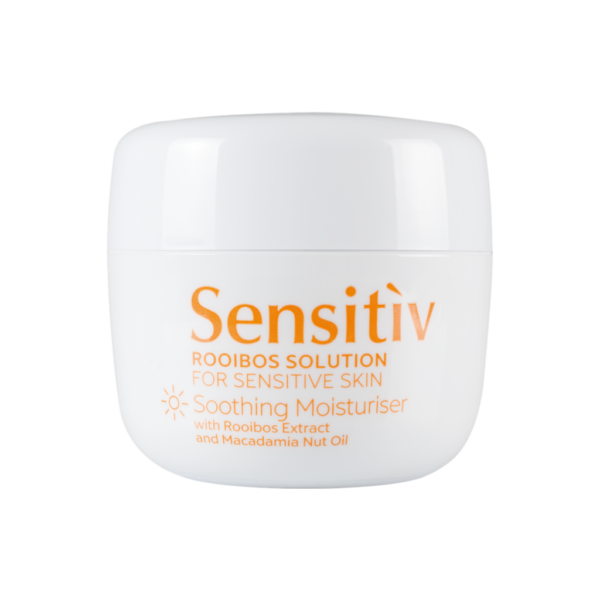Sensitive
Sensitìv Introduction
Across the world, millions of people perceive their skin as being sensitive and these numbers are growing. Based on months of research, Annique presents to you Sensitìv, the Rooibos solution for sensitive skin, the solution to your sensitive skincare concerns.
A sensitive skin and a sensitised skin exhibit the same symptoms and triggers, so it may be difficult to distinguish between the two. Understanding the differences could help you understand this skincare challenge and help you provide the best solution to your customer.

Sensitive skin
– Sensitive skin is caused by a genetic predisposition (DNA).You are born with it!
– These people are prone to blushing, asthma and allergies.
-It is not limited to fair or red-haired individuals. It is now evident that darker skin tones can also have a sensitive skin.
– Sensitive skin is prone to many skin conditions like
1. Psoriasis
2. Rosacea
3. Acne
4. Eczema
5. Atopic dermatitis or Seborrheic dermatitis
Sensitised skin
• Sensitised skin is a growing concern worldwide that affects people regardless of race, colour or age.
• It can be caused by:
1. exposure to environmental influences, such as pollution and UV rays from the sun
2. drastic changes in climate
3. medication
4. diet
5. lifestyle: lack of sleep, stress, smoking, improper skincare regimes.
Sensitive and Sensitised skin – both result in a weakness in the skin’s protective outer layer (epidermal lipid barrier)

Difference between Sensitive and Sensitised skin
Sensitised skin is the wolf in sheep’s clothing in the skin care world; it pretends to be something it is not. The hard part of distinguishing between the sensitive and sensitised skin is that they have similar symptoms and appearances.
Both conditions can cause the client to experience dehydration, burning, itching, swelling, uneven texture, facial redness, rashes, breakouts, and discomfort. Knowing that a client is merely temporarily sensitised allows you as the consultant to stop, slow down, and repair the broken-down barrier in order to return the client’s skin to its normal, functioning state.
Once this reversal occurs and this condition resolves, the professional can determine their client’s true skin type and create a customised treatment plan.
Sensitive skin runs much deeper than that of skin that simply reacts to products and treatments. This skin type has a true genetic makeup and those that have sensitive skin tend to come from a long line of family members that also have sensitive skin.
Clients with this skin type also tend to suffer from non-related skin sensitivities such as allergies, asthma, and flushing or blushing of the skin. They are typically also accustomed to experiencing other forms of skin rashes on the body such as eczema, rosacea, and other forms of dermatitis.
Sensitive skin types tend to have less pigment in their skin and a thinner epidermis, thus causing them to have less of a protective barrier for the skin, which opens it up to factors that lead to impaired barrier function.
Sensitive skin is not something that can ever truly be fixed as it is genetic. Fortunately, it can be helped.
Sensitised skin, on the other hand, has a weakened barrier because of internal and external factors from one’s immediate environment and habits that have caused the barrier to become temporarily impaired over time.
Sensitised skin tends to look lustreless, blotchy, dry, and visibly irritated. It also typically suffers from either an overproduction of oil or a lack of thereof. This skin also develops an assortment of dermatitis reactions that can be managed once the trigger(s) are determined.
Typically, sensitised skin can be contributed to one or more of the following internal and external factors: internal and external pro-inflammatory aggressors, overuse of chemical and manual exfoliants, changes in medication use, alcohol consumption, dehydration, poor diet, inadequate water intake, overexposure to the sun and extreme weather conditions, stress and use of the improper products for the skin.
It is the consultant’s responsibility to ask both lifestyle- and beauty-related questions to determine what might be causing changes in the client’s skin that is leading to sensitisation.
Fifty percent of the population believes they have sensitive skin, yet the majority of them are really experiencing sensitised skin due the increase of pollution, lifestyle, diet, medications, over-exfoliation, incorrect product use, and excess sun exposure.
The easiest way to conclude whether a client has sensitised or sensitive skin is to ask numerous questions during the consultation.
